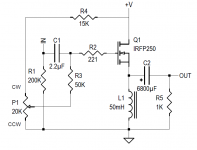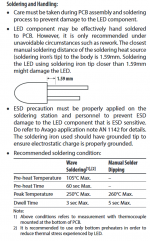Hi Mr. Salas
I have a very simple request.
I would like to use the new shunt on the M.Rotacher MoFo amplifier in its Big declination to deliver about 2.5A continuous on a 24V-DC voltage.
It's possible ?
With which precautions?
I have already built several shunts on your projects with great satisfaction.
Reflektor-D for my DAC
DCB1 and others.
Naturally, in previous situations I did not need high currents.
I have a very simple request.
I would like to use the new shunt on the M.Rotacher MoFo amplifier in its Big declination to deliver about 2.5A continuous on a 24V-DC voltage.
It's possible ?
With which precautions?
I have already built several shunts on your projects with great satisfaction.
Reflektor-D for my DAC
DCB1 and others.
Naturally, in previous situations I did not need high currents.
the Mofo is an amp source follower in class A that has no gain and is loaded by a large inductance on the source. The maximum current is set at 2.5A and B + 24V.How much is the peak to peak current that amp will ask for max signal output?
the schematic in attachement
Attachments
Anyways with IRF9640 M1 & IRF640 M2 it may do it. The burden is on M1 that will burn the voltage drop across the reg times the CCS setting constantly. That will be 15W if set at 3A assuming 5VDC across. M2 has it better with a high bias Class A amp as load because it will just burn the excess while the amp will pull the heavy part. You will see the reg's LEDS blink if the CCS is set low for the amp's needs with some speaker on peaks. Start with R1 0.22R 5W for circa 2.7A CC. Use a sink for M1 & M2 that will be at ease with at least 20W constantly.
Good !!Anyways with IRF9640 M1 & IRF640 M2 it may do it. The burden is on M1 that will burn the voltage drop across the reg times the CCS setting constantly. That will be 15W if set at 3A assuming 5VDC across. M2 has it better with a high bias Class A amp as load because it will just burn the excess while the amp will pull the heavy part. You will see the reg's LEDS blink if the CCS is set low for the amp's needs with some speaker on peaks. Start with R1 0.22R 5W for circa 2.7A CC. Use a sink for M1 & M2 that will be at ease with at least 20W constantly.
many Thanks Salas🙂
Watch where the main current goes when you will be setting it up though. You would either need a 100W 10R dummy load (sinked power resistor) or the amp itself hooked up because 65W will dissipate on M2 (24V @ 2.7A) frying it if there is no way out for the bulk of that bias!
Received Board yesterday.. have some BOM questions..
Thanks Teabag!
So this is for my Ba-3 line stage build, so my output voltages are +24v and -24V.
Current output I do not know, but shouldn't it be less than 1A?
First question, well CC current needed in the B-a3 circuit?
And btw what does CC stand for? Current.....and the other C?
Rs,Cx and Cs recommended?
And in the positive and negative parts descriptions there are references to IRF9610, IRF9530, and IRF610 and IRF530. Is this so? I want to be sure this is not a typo.
Thanks!
Thanks Teabag!
So this is for my Ba-3 line stage build, so my output voltages are +24v and -24V.
Current output I do not know, but shouldn't it be less than 1A?
First question, well CC current needed in the B-a3 circuit?
And btw what does CC stand for? Current.....and the other C?
Rs,Cx and Cs recommended?
And in the positive and negative parts descriptions there are references to IRF9610, IRF9530, and IRF610 and IRF530. Is this so? I want to be sure this is not a typo.
Thanks!
Is there a substitute for the Kingbright led's? tia.
The kingbright are consistent if their vf. Reds are 1.8v
The Kingbrighht greens are slightly higher at 1.9v
If your running for a goal of 5V, I know Salas recommends the red LEDS, as they have a lower Vf. The kingbright ones are all rated at 20ma.
Is there a substitute for the Kingbright led's? tia.
http://ie.farnell.com/broadcom-limi...d-2-1mcd-626nm/dp/1003207?st=broadcom red led
P.S. The above low power one says is consistent at circa 2mA (our circuit's working conditions territory). Same brand 6000 series measured best noise in member's "gerhard" noise tests. It might also prove sensitive for reliability because low power though? I don't know.
Thanks Teabag!
So this is for my Ba-3 line stage build, so my output voltages are +24v and -24V.
Current output I do not know, but shouldn't it be less than 1A?
First question, well CC current needed in the B-a3 circuit?
And btw what does CC stand for? Current.....and the other C?
Rs,Cx and Cs recommended?
And in the positive and negative parts descriptions there are references to IRF9610, IRF9530, and IRF610 and IRF530. Is this so? I want to be sure this is not a typo.
Thanks!
CC=constant current
In the BA-3 thread they talk that preamp's bias. Its 45mA typically. So 90mA for two channels. Use 3.3R 1W R1 for 180mA CC to have enough spare and not too much heat on the reg's sinks.
Rs, Cx, Cs, values can't be recommended. That's an individual transformer and bridge diodes situation thing. Its either you have the Quasimodo gadget or other lab measurement ways to snubber the transformer's ringing or you don't use those parts.
Yes for below 1A CC you can use IRF9610 M1 in the positive and IRF610 M1 in the negative. IRF530 M2 in the positive and IRF9530 M2 in the negative are standard. The analogous fast Fairchild FQPs for M1 are good for 1.5A CC but also develop higher VGS.
In general, read the Ultrabib's build guide attached in post#1
http://ie.farnell.com/broadcom-limi...d-2-1mcd-626nm/dp/1003207?st=broadcom red led
P.S. The above low power one says is consistent at circa 2mA (our circuit's working conditions territory). Same brand 6000 series measured best noise in member's "gerhard" noise tests. It might also prove sensitive for reliability because low power though? I don't know.
Thank you.
Thank you.
Alright. In the precautions section it says not to manually solder that type any closer than 1.59mm to its body. So populate it bit proud above the PCB. The FR4 is thick enough but some solder will flow to the upper side also through the plated holes.
http://www.farnell.com/datasheets/1918234.pdf
Attachments
Question regarding kingbright leds and bc327-40
Does the color matter? And it looks that digikey does not carry them, cannot find these in their site, maybe someone has been able to find it...
And the bc327-40 transistor appears with a bunch of suffixes after the number 40, like ta, hub, etc. does that matter? Thanks
Does the color matter? And it looks that digikey does not carry them, cannot find these in their site, maybe someone has been able to find it...
And the bc327-40 transistor appears with a bunch of suffixes after the number 40, like ta, hub, etc. does that matter? Thanks
It should be red if you want the reg to reach at 5V low. Because red has lower Vf. If you don't need that low voltage and you go for >6Vout you can also use green amber yellow. Red tend to have best self noise as well but its not certain between brands. They are filtered by C2 along with the trimmer & VRR anyway. Mouser has the Kingbright flat profiled ones I think, which proved Vf consistent and reliable. But you can use any good brand low Vf LEDS.
The suffixes after 40 don't really matter to us. Maybe they mean kinked lead, ammo pack, bulk, etc.
The suffixes after 40 don't really matter to us. Maybe they mean kinked lead, ammo pack, bulk, etc.
P.S. If anybody will have to use Zener for Vref in place of VRR, the Vishay BZX55 series looks practical enough for this circuit. But remember to deduct 4.7V from its Vz (when with red LEDS). And also don't put the VR1 trimmer in the PCB of course. Say you want a 12V fixed UltraBiB with Zener, you put a BZX55 with 7.5Vz for example. 7.5+4.7=12.2V and so on and so forth. Zener orientation for both sections is described in the build guide.
View attachment 688370
Salas/Tea,
Received the minis and boards Thursday, and Ive been busy!
Cheers,
Greg
Hi Greg,
First time I see a final PCB issue Ultra assembled. Looking cool in black. Well arranged, congrats. My two GB grade PCBs left America June 22.
P.S. Why R8 & R9 are missing?
- Home
- Amplifiers
- Power Supplies
- Salas SSLV1.3 UltraBiB shunt regulator


